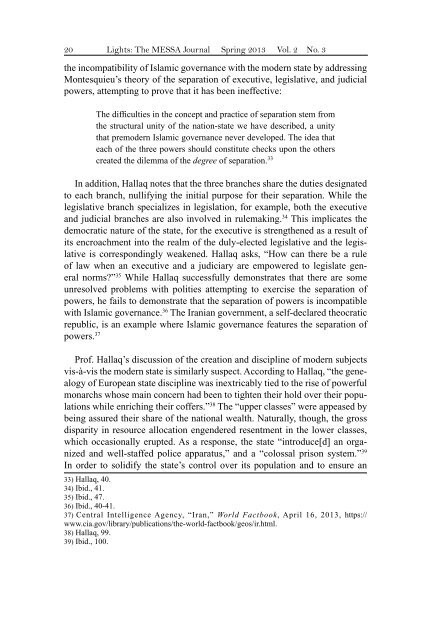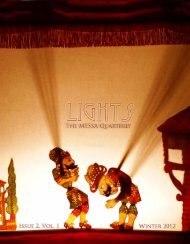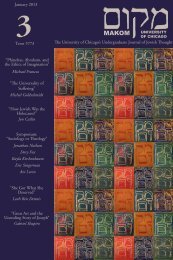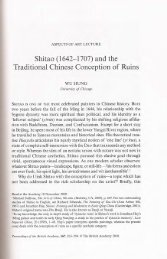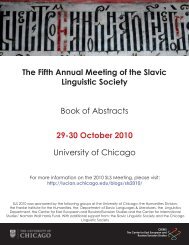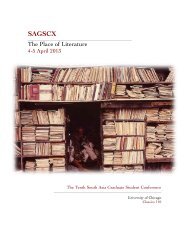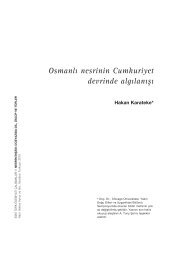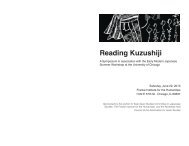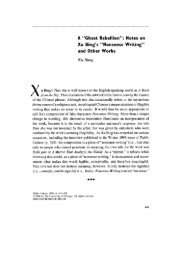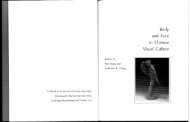Create successful ePaper yourself
Turn your PDF publications into a flip-book with our unique Google optimized e-Paper software.
20 Lights: The MESSA Journal Spring 2013 Vol. 2 No. 3<br />
the incompatibility <strong>of</strong> Islamic governance with the modern state by addressing<br />
Montesquieu’s theory <strong>of</strong> the separation <strong>of</strong> executive, legislative, and judicial<br />
powers, attempting to prove that it has been ineffective:<br />
The difficulties in the concept and practice <strong>of</strong> separation stem from<br />
the structural unity <strong>of</strong> the nation-state we have described, a unity<br />
that premodern Islamic governance never developed. The idea that<br />
each <strong>of</strong> the three powers should constitute checks upon the others<br />
created the dilemma <strong>of</strong> the degree <strong>of</strong> separation. 33<br />
In addition, Hallaq notes that the three branches share the duties designated<br />
to each branch, nullifying the initial purpose for their separation. While the<br />
legislative branch specializes in legislation, for example, both the executive<br />
and judicial branches are also involved in rulemaking. 34 This implicates the<br />
democratic nature <strong>of</strong> the state, for the executive is strengthened as a result <strong>of</strong><br />
its encroachment into the realm <strong>of</strong> the duly-elected legislative and the legislative<br />
is correspondingly weakened. Hallaq asks, “How can there be a rule<br />
<strong>of</strong> law when an executive and a judiciary are empowered to legislate general<br />
norms?” 35 While Hallaq successfully demonstrates that there are some<br />
unresolved problems with polities attempting to exercise the separation <strong>of</strong><br />
powers, he fails to demonstrate that the separation <strong>of</strong> powers is incompatible<br />
with Islamic governance. 36 The Iranian government, a self-declared theocratic<br />
republic, is an example where Islamic governance features the separation <strong>of</strong><br />
powers. 37<br />
Pr<strong>of</strong>. Hallaq’s discussion <strong>of</strong> the creation and discipline <strong>of</strong> modern subjects<br />
vis-à-vis the modern state is similarly suspect. According to Hallaq, “the genealogy<br />
<strong>of</strong> European state discipline was inextricably tied to the rise <strong>of</strong> powerful<br />
monarchs whose main concern had been to tighten their hold over their populations<br />
while enriching their c<strong>of</strong>fers.” 38 The “upper classes” were appeased by<br />
being assured their share <strong>of</strong> the national wealth. Naturally, though, the gross<br />
disparity in resource allocation engendered resentment in the lower classes,<br />
which occasionally erupted. As a response, the state “introduce[d] an organized<br />
and well-staffed police apparatus,” and a “colossal prison system.” 39<br />
In order to solidify the state’s control over its population and to ensure an<br />
33) Hallaq, 40.<br />
34) Ibid., 41.<br />
35) Ibid., 47.<br />
36) Ibid., 40-41.<br />
37) Central Intelligence Agency, “Iran,” World Factbook, April 16, 2013, https://<br />
www.cia.gov/library/publications/the-world-factbook/geos/ir.html.<br />
38) Hallaq, 99.<br />
39) Ibid., 100.


